Hadoop生态圈-Flume的组件之拦截器与选择器
Hadoop生态圈-Flume的组件之拦截器与选择器
作者:尹正杰
版权声明:原创作品,谢绝转载!否则将追究法律责任。
本篇博客只是配置的是Flume主流的Interceptors,想要了解更详细的配置信息请参考官网:http://flume.apache.org/FlumeUserGuide.html#flume-interceptors。
想必大家都知道Flume的组件有Source,channel和sink。其实在Flume还有一些更深层的东西,比如你知道soucre是如何将数据传送给channel的吗?那你有知道channel又是如何将数据发送给sink的吗?对于一个Agent来说,它只能有一个source,但是它可以有多个channel和sink,如下图:
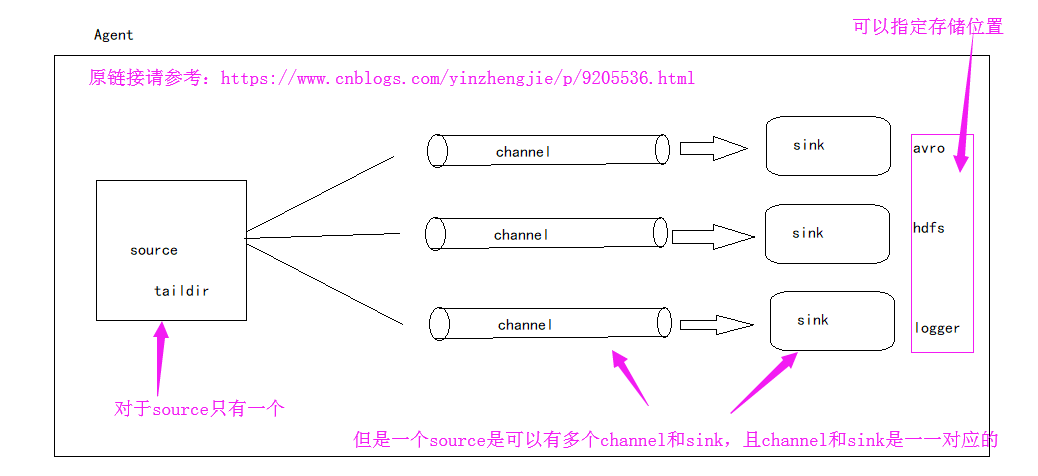
接下来就跟着我一起了了解一下更深层次的知识吧。接下来我们就一起探讨一下source是如何将数据发送到channel中的,以及sink是处理数据的。
一.Source端源码查看
1>.获取一行数据,使用其构建Event

2>.使用processEvent处理数据
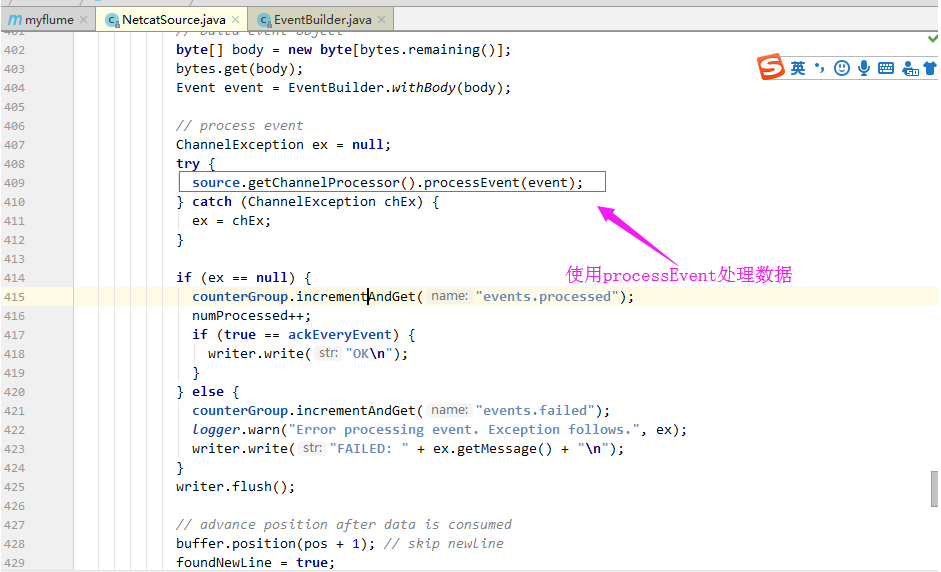
3>.在处理过程中,event需要通过拦截器链,相当于过滤数据
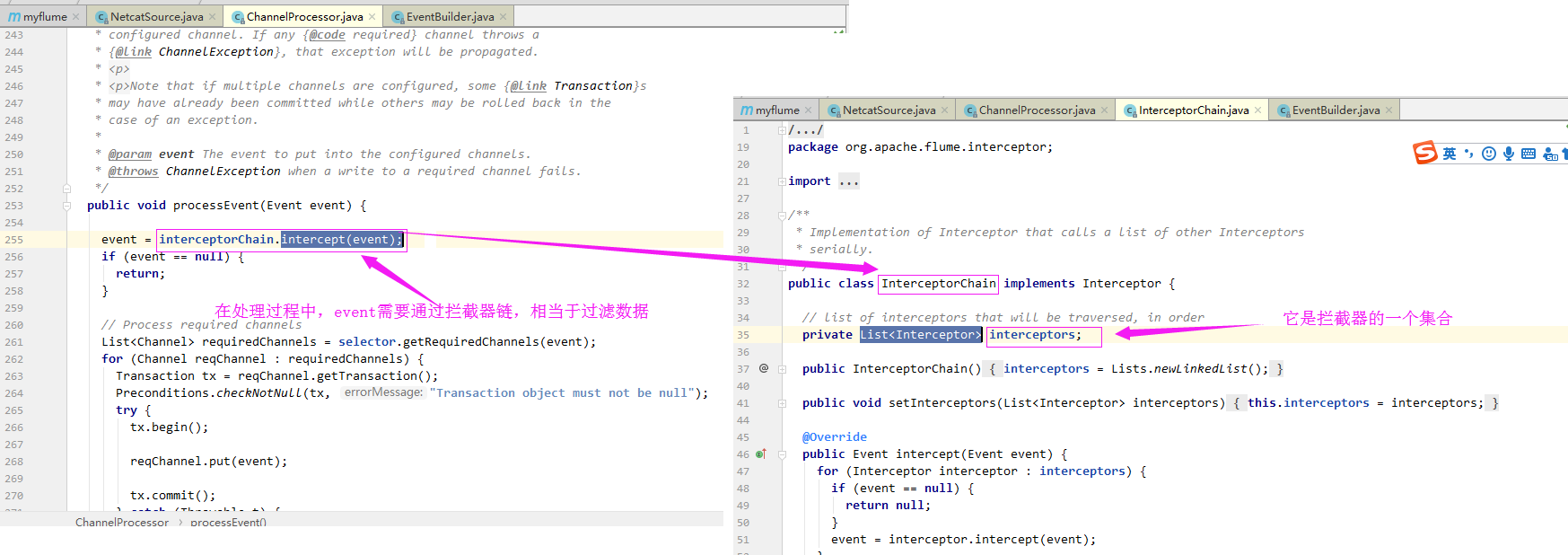
4>.在拦截器链中,通过迭代所有拦截器,对数据进行多次处理(例如:host拦截器,是对event进行添加头部操作)
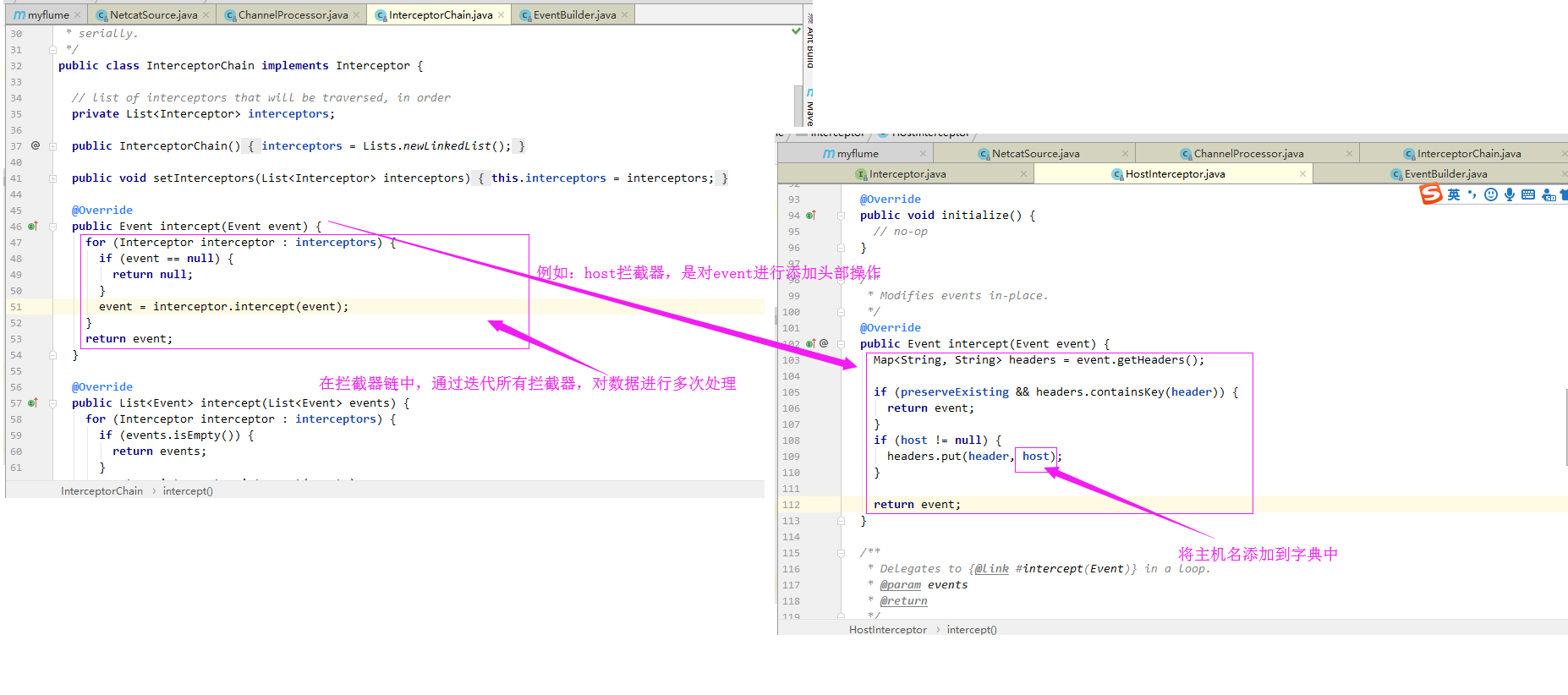
5>.通过拦截器处理后的event,再次进入到通道挑选器
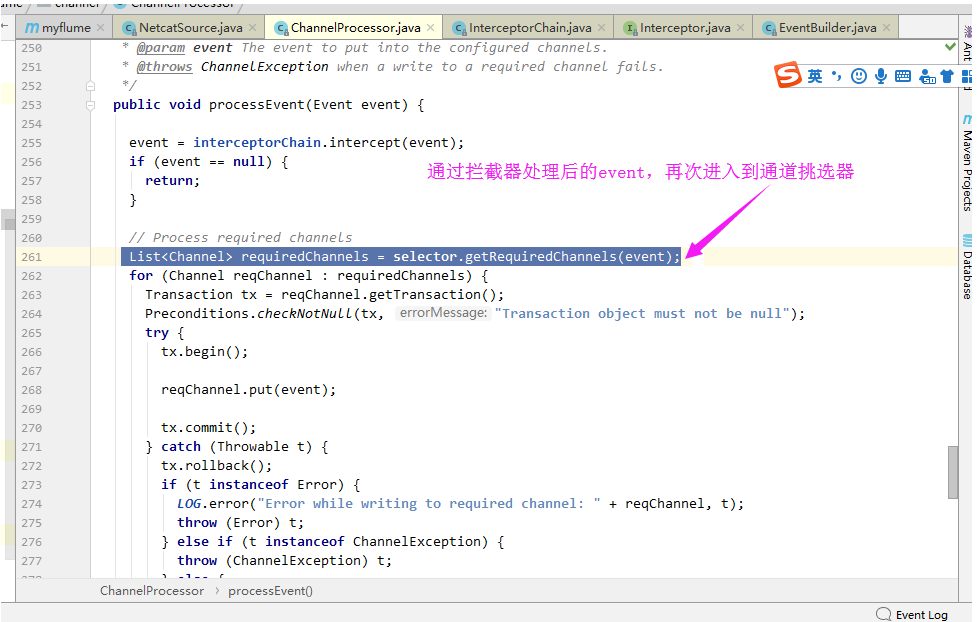
6>.迭代所有channel,将数据放进channel中

通过上面的源码解析,看下面这张图应该就不是什么难事了吧:
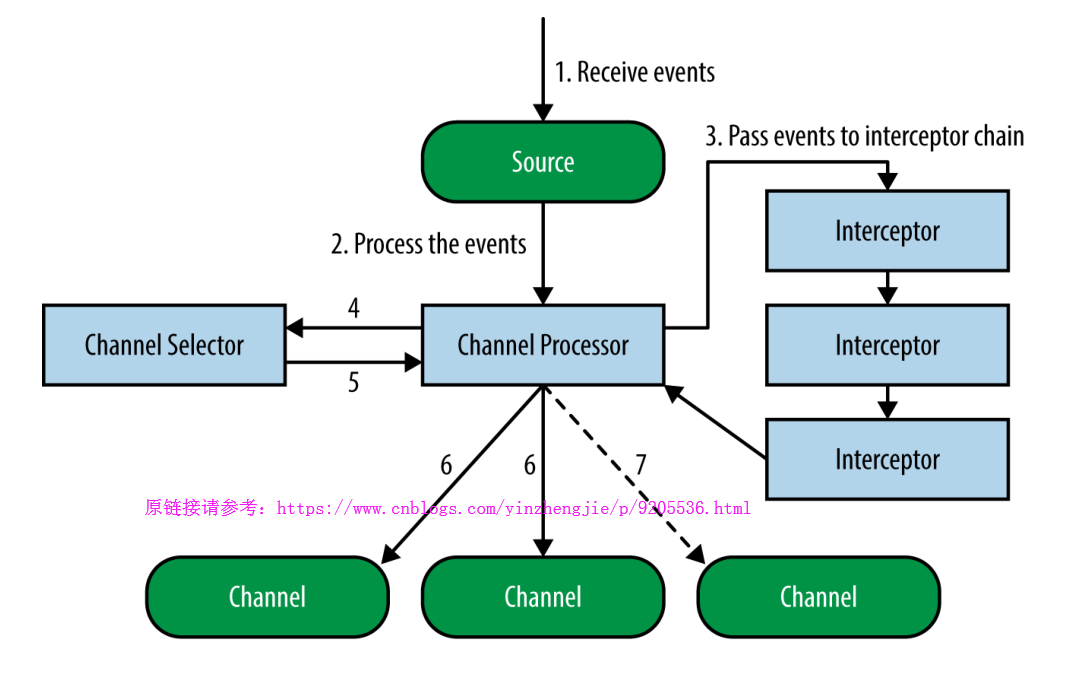
这个时候,你是否绝对第一张图画得并不自信呢?这个时候我们可以把第一张图的Source端流程画得更详细一点,如下:
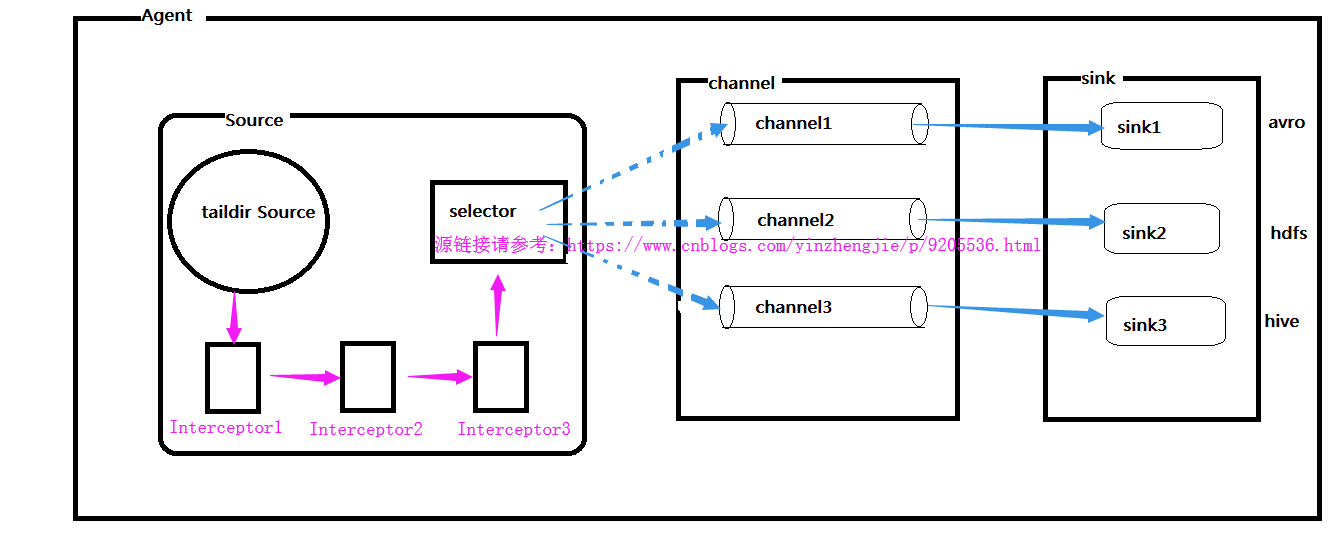
二.拦截器(Interceptors)
1>.Interceptors 功能
答:拦截器是在source端的在处理过程中能够对数据(event)进行修改或丢弃的组件。
2>.官方文档
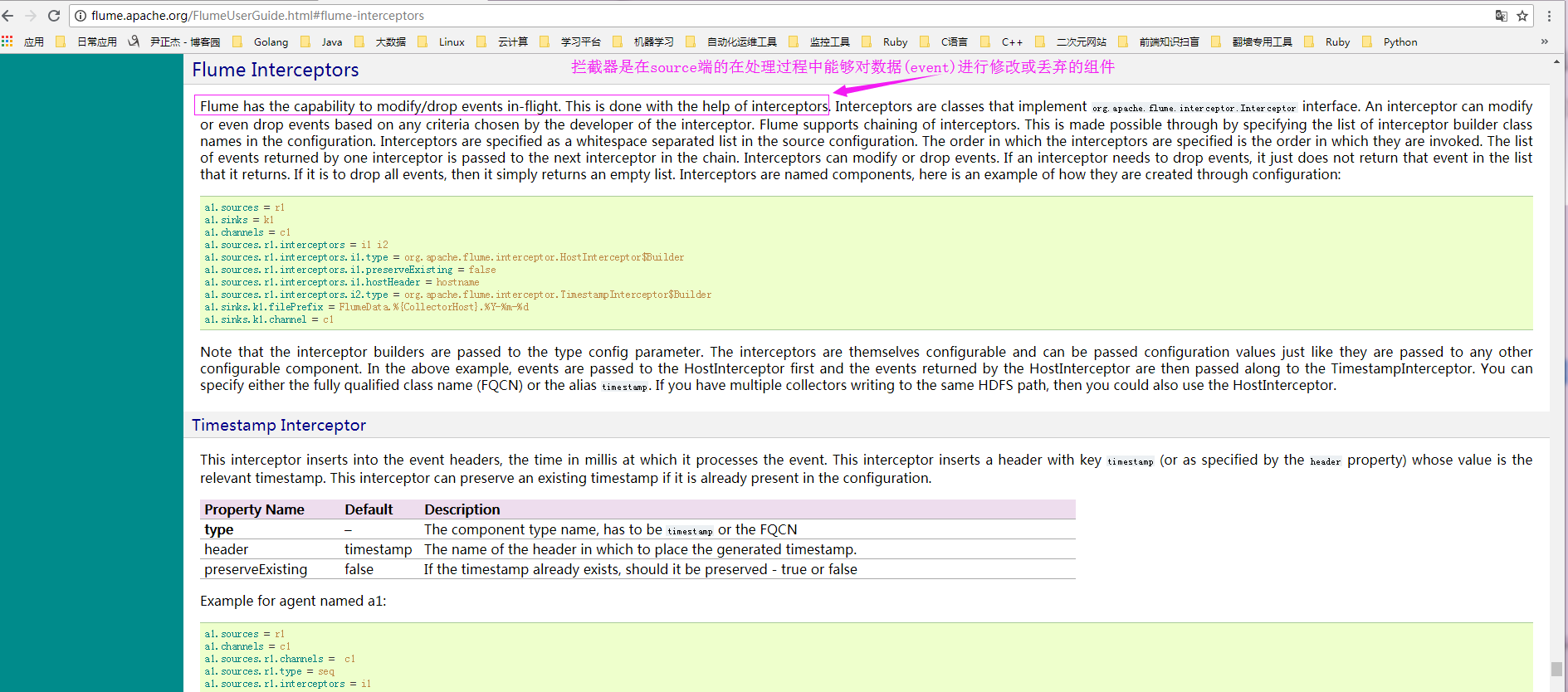
3>.host interceptor(将发送的event添加主机名的header)配置案例
a>.实际配置参数:
[yinzhengjie@s101 ~]$ more /soft/flume/conf/yinzhengjie_hostInterceptor.conf
# Name the components on this agent
a1.sources = r1
a1.sinks = k1
a1.channels = c1 # Describe/configure the source
a1.sources.r1.type = netcat
a1.sources.r1.bind = localhost
a1.sources.r1.port = # 指定添加拦截器
a1.sources.r1.interceptors = i1
a1.sources.r1.interceptors.i1.type = org.apache.flume.interceptor.HostInterceptor$Builder
a1.sources.r1.interceptors.i1.preserveExisting = false
# 指定header的key
a1.sources.r1.interceptors.i1.hostHeader = hostname
# 指定header的value为主机ip
a1.sources.r1.interceptors.i1.useIP = true # Describe the sink
a1.sinks.k1.type = logger # Use a channel which buffers events in memory
a1.channels.c1.type = memory
a1.channels.c1.capacity =
a1.channels.c1.transactionCapacity = # Bind the source and sink to the channel
a1.sources.r1.channels = c1
a1.sinks.k1.channel = c1
[yinzhengjie@s101 ~]$
b>启动agent进程:
c>.source端产生数据(启动nc):
d>.检查sink端数据(检查定义好的目录"/home/yinzhengjie/log2")
4>.static interceptor(静态拦截器,手动指定key-value)配置案例
a>.实际配置参数:
[yinzhengjie@s101 ~]$ more /soft/flume/conf/yinzhengjie_staticInterceptor.conf
# Name the components on this agent
a1.sources = r1
a1.sinks = k1
a1.channels = c1 # Describe/configure the source
a1.sources.r1.type = netcat
a1.sources.r1.bind = localhost
a1.sources.r1.port = # 指定添加拦截器
a1.sources.r1.interceptors = i1
a1.sources.r1.interceptors.i1.type = static
a1.sources.r1.interceptors.i1.key = name
a1.sources.r1.interceptors.i1.value = yinzhengjie # Describe the sink
a1.sinks.k1.type = logger # Use a channel which buffers events in memory
a1.channels.c1.type = memory
a1.channels.c1.capacity =
a1.channels.c1.transactionCapacity = # Bind the source and sink to the channel
a1.sources.r1.channels = c1
a1.sinks.k1.channel = c1
[yinzhengjie@s101 ~]$
b>启动agent进程:
c>.source端产生数据(启动nc):
d>.检查sink端数据(检查定义好的目录"/home/yinzhengjie/log2")
5>.timestamp interceptor(将发送的event添加时间戳的header)配置案例
a>.实际配置参数:
[yinzhengjie@s101 ~]$ more /soft/flume/conf/yinzhengjie_timestampInterceptor.conf
# Name the components on this agent
a1.sources = r1
a1.sinks = k1
a1.channels = c1 # Describe/configure the source
a1.sources.r1.type = netcat
a1.sources.r1.bind = localhost
a1.sources.r1.port = # 指定添加拦截器
a1.sources.r1.interceptors = i1
a1.sources.r1.interceptors.i1.type = timestamp # Describe the sink
a1.sinks.k1.type = logger # Use a channel which buffers events in memory
a1.channels.c1.type = memory
a1.channels.c1.capacity =
a1.channels.c1.transactionCapacity = # Bind the source and sink to the channel
a1.sources.r1.channels = c1
a1.sinks.k1.channel = c1
[yinzhengjie@s101 ~]$
b>启动agent进程:
c>.source端产生数据(启动nc):
d>.检查sink端数据(检查定义好的目录"/home/yinzhengjie/log2")
6>.interceptor chain(连接器链)配置案例
a>.实际配置参数:
[yinzhengjie@s101 ~]$ more /soft/flume/conf/yinzhengjie_chainInterceptor.conf
# Name the components on this agent
a1.sources = r1
a1.sinks = k1
a1.channels = c1 # Describe/configure the source
a1.sources.r1.type = netcat
a1.sources.r1.bind = localhost
a1.sources.r1.port = # 指定添加拦截器
a1.sources.r1.interceptors = i1 i2 i3
a1.sources.r1.interceptors.i1.type = org.apache.flume.interceptor.HostInterceptor$Builder
a1.sources.r1.interceptors.i1.preserveExisting = false
# 指定header的key
a1.sources.r1.interceptors.i1.hostHeader = hostname
# 指定header的value为主机ip
a1.sources.r1.interceptors.i1.useIP = true # 添加i2拦截器
a1.sources.r1.interceptors.i2.type = timestamp # 添加i3拦截器
a1.sources.r1.interceptors.i3.type = remove_header
a1.sources.r1.interceptors.i3.withName = timestamp # Describe the sink
a1.sinks.k1.type = logger # Use a channel which buffers events in memory
a1.channels.c1.type = memory
a1.channels.c1.capacity =
a1.channels.c1.transactionCapacity = # Bind the source and sink to the channel
a1.sources.r1.channels = c1
a1.sinks.k1.channel = c1 [yinzhengjie@s101 ~]$
b>启动agent进程:
c>.source端产生数据(启动nc):
d>.检查sink端数据(检查定义好的目录"/home/yinzhengjie/log2")
Hadoop生态圈-Flume的组件之拦截器与选择器的更多相关文章
- Hadoop生态圈-Flume的组件之自定义拦截器(interceptor)
Hadoop生态圈-Flume的组件之自定义拦截器(interceptor) 作者:尹正杰 版权声明:原创作品,谢绝转载!否则将追究法律责任. 本篇博客只是举例了一个自定义拦截器的方法,测试字节传输速 ...
- Hadoop生态圈-Flume的组件之自定义Sink
Hadoop生态圈-Flume的组件之自定义Sink 作者:尹正杰 版权声明:原创作品,谢绝转载!否则将追究法律责任. 本篇博客主要介绍sink相关的API使用两个小案例,想要了解更多关于API的小技 ...
- Hadoop生态圈-Flume的组件之sink处理器
Hadoop生态圈-Flume的组件之sink处理器 作者:尹正杰 版权声明:原创作品,谢绝转载!否则将追究法律责任. 一. 二.
- Hadoop生态圈-Flume的主流source源配置
Hadoop生态圈-Flume的主流source源配置 作者:尹正杰 版权声明:原创作品,谢绝转载!否则将追究法律责任. 本篇博客只是配置的是Flume主流的Source,想要了解更详细的配置信息请参 ...
- Hadoop生态圈-flume日志收集工具完全分布式部署
Hadoop生态圈-flume日志收集工具完全分布式部署 作者:尹正杰 版权声明:原创作品,谢绝转载!否则将追究法律责任. 目前为止,Hadoop的一个主流应用就是对于大规模web日志的分析和处理 ...
- 基于ambari搭建hadoop生态圈大数据组件
Ambari介绍1Apache Ambari是一种基于Web的工具,支持Apache Hadoop集群的供应.管理和监控.Ambari已支持大多数Hadoop组件,包括HDFS.MapReduce.H ...
- Hadoop生态圈-Flume的主流Channel源配置
Hadoop生态圈-Flume的主流Channel源配置 作者:尹正杰 版权声明:原创作品,谢绝转载!否则将追究法律责任. 一. 二. 三.
- Hadoop生态圈-Flume的主流Sinks源配置
Hadoop生态圈-Flume的主流Sinks源配置 作者:尹正杰 版权声明:原创作品,谢绝转载!否则将追究法律责任. 本篇博客只是配置的是Flume主流的Sinks,想要了解更详细的配置信息请参考官 ...
- Flume 拦截器(interceptor)详解
flume 拦截器(interceptor)1.flume拦截器介绍拦截器是简单的插件式组件,设置在source和channel之间.source接收到的事件event,在写入channel之前,拦截 ...
随机推荐
- mybatis源码-解析配置文件(二)之解析的流程
目录 1. 简介 2. 配置文件解析流程分析 2.1 调用 2.2 解析的目的 2.3 XML 解析流程 2.3.1 build(parser) 2.3.2 new XMLConfigBuilder( ...
- Markdown之语法入门篇
Markdown语法入门 一.什么是Markdown语言 我相信有很多小伙伴没有听说过Markdown语言.的确,对于一般人来说,有word足够了.但是有这么一群人,受够了word那糟糕的排版方式,需 ...
- .Net Core 分布式微服务框架介绍 - Jimu
系列文章 .Net Core 分布式微服务框架介绍 - Jimu .Net Core 分布式微服务框架 - Jimu 添加 Swagger 支持 一.前言 近些年一直浸淫在 .Net 平台做企业应用开 ...
- Asp.Net_优化
ASP.NET: 一.返回多个数据集 检查你的访问数据库的代码,看是否存在着要返回多次的请求.每次往返降低了你的应用程序的每秒能够响应请求的次数.通过在单个数据库请求中返回多个结果集,可以减少与数据库 ...
- C# List left join
public class Test1 { public int ID { get; set; } public string Name { get; set; } } public class Tes ...
- 深入浅出etcd系列Part 1 – etcd架构和代码框架
1.绪论 etcd作为华为云PaaS的核心部件,实现了PaaS大多数组件的数据持久化.集群选举.状态同步等功能.如此重要的一个部件,我们只有深入地理解其架构设计和内部工作机制,才能更好地学习华为云Ku ...
- 利用KMP算法解决串的模式匹配问题(c++) -- 数据结构
题目: 7-1 串的模式匹配 (30 分) 给定一个主串S(长度<=10^6)和一个模式T(长度<=10^5),要求在主串S中找出与模式T相匹配的子串,返回相匹配的子串中的第一个字符在主串 ...
- wpf-典型的mvvm模式通用中小型管理系统框架0
之前就一直在想着写这么一系列博客,将前段时间(也算有点久了)自己编写的一套框架分享下,和园子里的诸位大牛交流交流,奈何文思枯竭,提键盘而无从敲起,看来只有coding时才不会有这种裤子都脱了,才发现对 ...
- BugPhobia沟通篇章:Solr模式配置与数据导入调研
0x01 :Scrum Meeting特别说明 特别说明,考虑到编译原理课程考核的时间安排,每天开发时间急剧缩短以至于难以维系正常的Scrum Meeting,因此,将2015/12/13 00:00 ...
- Linux内核分析第三周学习笔记
linux内核分析第三周学习笔记 标签(空格分隔): 20135328陈都 陈都 原创作品转载请注明出处 <Linux内核分析>MOOC课程http://mooc.study.163.co ...
